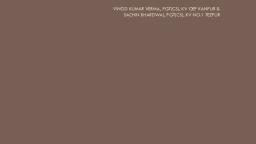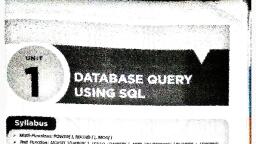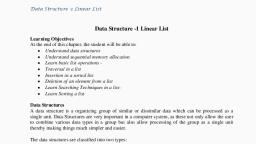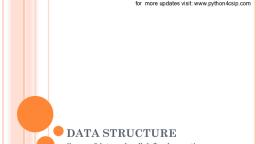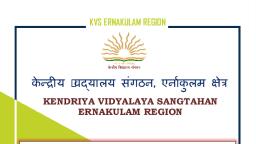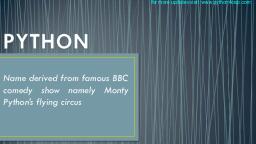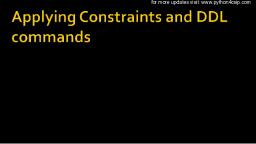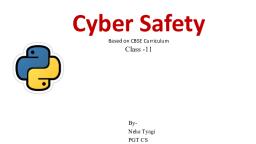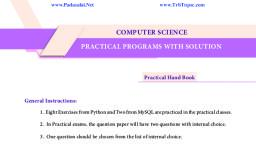Page 2 :
for more updates visit: www.python4csip.com, , Python was created by Guido Van Rossum, The language was released in February I991, Python got its name from a BBC comedy series from seventies“Monty Python‟s Flying Circus”, Python can be used to follow both Procedural approach and, Object Oriented approach of programming, It is free to use, Python is based on or influenced with two programming, languages:, ABC language [replacement of BASIC], Modula-3, VINOD KUMAR VERMA, PGT(CS), KV OEF KANPUR &, SACHIN BHARDWAJ, PGT(CS), KV NO.1 TEZPUR
Page 5 :
for more updates visit: www.python4csip.com, , In a passage of text, individual words and punctuation, marks are called tokens or lexical units or lexical, elements. The smallest individual unit in a program is, known as Tokens. Python has following tokens:, Literals, , , , , , , , # Simple Python Program, Keywords, for i in range(1,10):, Identifiers(Name), if i %2 != 0:, Punctuators, Literals, print(i), Operators, Operators Keywords, Punctuators, Identifier, VINOD KUMAR VERMA, PGT(CS), KV OEF KANPUR &, SACHIN BHARDWAJ, PGT(CS), KV NO.1 TEZPUR
Page 7 :
for more updates visit: www.python4csip.com, , Are the names given to different parts of program like variables,, objects, classes, functions etc., Identifier forming rules of Python are :, Is an arbitrarily long sequence of letters and digits, The first character must be letter or underscore, Upper and lower case are different, The digits 0-9 are allowed except for first character, It must not be a keyword, No special characters are allowed other than underscore is allowed., Space not allowed, VINOD KUMAR VERMA, PGT(CS), KV OEF KANPUR &, SACHIN BHARDWAJ, PGT(CS), KV NO.1 TEZPUR
Page 10 :
for more updates visit: www.python4csip.com, , • It is a collection of character(s) enclosed in a double or single, quotes. It can be either Single line strings or Multiline Strings, • SINGLE LINE STRING : must terminate in one line i.e. the closing, quotes should be on the same line as that of the opening quotes, • Examples of String literals, • “Python”, • “Mogambo”, • „123456‟, • „Hello How are your‟, • „$‟, „4‟,”@@”, • In Python both single character or multiple characters enclosed, in quotes such as “kv”, „kv‟,‟*‟,”+” are treated as same, VINOD KUMAR VERMA, PGT(CS), KV OEF KANPUR &, SACHIN BHARDWAJ, PGT(CS), KV NO.1 TEZPUR
Page 13 :
for more updates visit: www.python4csip.com, , • Python determines the size of string as the count of characters in the, string. For example size of string “xyz” is 3 and of “welcome” is 7., But if your string literal has an escape sequence contained in it then, make sure to count the escape sequence as one character. For e.g., String, , Size, , „\\‟, , 1, , „abc‟, , 3, , „\ab‟, , 2, , “Meera\‟s Toy”, , 11, , “Vicky‟s”, , 7, , • You can check these size using len() function of Python. For example, • >>>len(„abc‟) and press enter, it will show the size as 3, VINOD KUMAR VERMA, PGT(CS), KV OEF KANPUR &, SACHIN BHARDWAJ, PGT(CS), KV NO.1 TEZPUR
Page 14 :
for more updates visit: www.python4csip.com, , • The numeric literals in Python can belong to any of the, following numerical types:, 1) INTEGER LITERALS: it contain at least one digit and must, not contain decimal point. It may contain (+) or (-) sign., • Types of Integer Literals:, a) Decimal : 1234, -50, +100, b) Octal : it starts from symbol 0o (zero followed by, letter ‘o’), , • For e.g. 0o10 represent decimal 8, VINOD KUMAR VERMA, PGT(CS), KV OEF KANPUR &, SACHIN BHARDWAJ, PGT(CS), KV NO.1 TEZPUR
Page 16 :
for more updates visit: www.python4csip.com, , • 2) Floating point Literals: also known as real literals. Real, , literals are numbers having fractional parts. It is, represented in two forms Fractional Form or Exponent Form, • Fractional Form: it is signed or unsigned with decimal point, • For e.g. 12.0, -15.86, 0.5, 10. (will represent 10.0), , • Exponent Part: it consists of two parts “Mantissa” and “Exponent”., • For e.g. 10.5 can be represented as 0.105 x 102 = 0.105E02 where 0.105, is mantissa and 02 (after letter E) is exponent, , 3) Complex number Literals : Complex number in python is made up, of two floating point values, one each for real and imaginary part., Example, >>> x = 1+0j, >>> print x.real,x.imag, 1.0 0.0, VINOD KUMAR VERMA, PGT(CS), KV OEF KANPUR &, SACHIN BHARDWAJ, PGT(CS), KV NO.1 TEZPUR
Page 19 :
for more updates visit: www.python4csip.com, , • are symbol that perform specific operation when applied on, variables. Take a look at the expression:, , (Operator), 10 + 25, , (Operands), , Above statement is an expression (combination, of operator and operands), i.e. operator operates on operand. some operator requires two, operand and some requires only one operand to operate, , VINOD KUMAR VERMA, PGT(CS), KV OEF KANPUR &, SACHIN BHARDWAJ, PGT(CS), KV NO.1 TEZPUR
Page 22 :
for more updates visit: www.python4csip.com, , Indentation, , Statements, , • It means basic structure of a Python program, • Take a look of following code:, , #This program shows a program‟s component, # Definition of function SeeYou() follows, def SeeYou():, print(“This is my function”), Function, #Main program, A=10, Expressions, B=A+20, C=A+B, if(C>=100), #checking condition, print(“Value is equals or more than 100”), else:, print(“Value is less than 100”), SeeYou(), #Calling Function, VINOD KUMAR VERMA, PGT(CS), KV OEF KANPUR &, SACHIN BHARDWAJ, PGT(CS), KV NO.1 TEZPUR, , Comments, , Inline Comment, , Block
Page 23 :
for more updates visit: www.python4csip.com, , • Variables are named temporary location used to store, values which can be further used in calculations, printing, result etc. Every variable must have its own Identity, type, and value. Variable in python is created by simply, assigning value of desired type to them., • For e.g, • Num = 100, • Name=“James”, , VINOD KUMAR VERMA, PGT(CS), KV OEF KANPUR &, SACHIN BHARDWAJ, PGT(CS), KV NO.1 TEZPUR
Page 24 :
for more updates visit: www.python4csip.com, , • Note: Python variables are not storage containers like other, programming language. Let us analyze by example., • In C++, if we declare a variable radius:, radius = 100, [suppose memory address is 41260], Now we again assign new value to radius, radius = 500, Now the memory address will be still same only value, will change, VINOD KUMAR VERMA, PGT(CS), KV OEF KANPUR &, SACHIN BHARDWAJ, PGT(CS), KV NO.1 TEZPUR
Page 25 :
for more updates visit: www.python4csip.com, , • Now let us take example of Python:, radius = 100, [memory address 3568], radius = 700, , [memory address 8546], , Now you can see that In python, each time you assign new, value to variable it will not use the same memory address, and new memory will be assigned to variable. In python the, location they refer to changes every time their value, change.(This rule is not for all types of variables), VINOD KUMAR VERMA, PGT(CS), KV OEF KANPUR &, SACHIN BHARDWAJ, PGT(CS), KV NO.1 TEZPUR
Page 26 :
for more updates visit: www.python4csip.com, , • In Python, a variable declared as numeric type can be, further used to store string type or another., • Dynamic typing means a variable pointing to a value of, certain type can be made to point to value/object of, different type., • Lets us understand with example, x = 100, # numeric type, print(x), x=“KV OEF”, # now x point to string type, print(x), VINOD KUMAR VERMA, PGT(CS), KV OEF KANPUR &, SACHIN BHARDWAJ, PGT(CS), KV NO.1 TEZPUR
Page 29 :
for more updates visit: www.python4csip.com, , • Dynamic typing is different from Static typing. In Static, Typing, a data type is attached with a variable when it, is defined first and it is fixed. That is data type of, variable cannot be changed in Static typing whereas, there is no such restriction in dynamic typing, which is, supported by Python., , VINOD KUMAR VERMA, PGT(CS), KV OEF KANPUR &, SACHIN BHARDWAJ, PGT(CS), KV NO.1 TEZPUR
Page 30 :
for more updates visit: www.python4csip.com, , • Python is very versatile with assignments. Let‟s see in how, different ways we can use assignment in Python:, 1. Assigning same value to multiple variable, a = b = c = 50, 2. Assigning multiple values to multiple variable, a,b,c = 11,22,33, , Note: While assigning values through multiple assignment,, remember that Python first evaluates the RHS and then, assigns them to LHS, , VINOD KUMAR VERMA, PGT(CS), KV OEF KANPUR &, SACHIN BHARDWAJ, PGT(CS), KV NO.1 TEZPUR
Page 31 :
for more updates visit: www.python4csip.com, , x,y,z = 10,20,30, #Statement 1, z,y,x = x+1,z+10,y-10 #Statement 2, print(x,y,z), Output will be, 10 40 11, , Now guess the output of following code fragment, x,y = 7,9, y,z = x-2, x+10, print(x,y,z), VINOD KUMAR VERMA, PGT(CS), KV OEF KANPUR &, SACHIN BHARDWAJ, PGT(CS), KV NO.1 TEZPUR
Page 32 :
for more updates visit: www.python4csip.com, , Let us take another example, , y, y = 10, 20, In above code first it will assign 10 to y and again it assign 20, to y, so if you print the value of y it will print 20, Now guess the output of following code, x, x = 100,200, y,y = x + 100, x +200, print(x,y), VINOD KUMAR VERMA, PGT(CS), KV OEF KANPUR &, SACHIN BHARDWAJ, PGT(CS), KV NO.1 TEZPUR
Page 33 :
for more updates visit: www.python4csip.com, , • In python we can take input from user using the built-in, function input()., • Syntax, variable = input(<message to display>), Note: value taken by input() function will always be of String type, so by, default you will not be able to perform any arithmetic operation on variable., >>> marks=input("Enter your marks "), Enter your marks 100, >>> type(marks), <class 'str'>, Here you can see even we are entering value 100 but it will be treated as, string and will not allow any arithmetic operation., VINOD KUMAR VERMA, PGT(CS), KV OEF KANPUR &, SACHIN BHARDWAJ, PGT(CS), KV NO.1 TEZPUR
Page 35 :
for more updates visit: www.python4csip.com, , • Now we are aware that input() function value will, always be of string type, but what to do if we want, number to be entered. The solution to this problem is to, convert values of input() to numeric type using int() or, float() function., >>> age = int(input(“Enter your age “)), >>>print type(age), <type „int‟>, >>>salary = float(input(“Enter salary”)), >>>print type(salary), <type „float‟>, VINOD KUMAR VERMA, PGT(CS), KV OEF KANPUR &, SACHIN BHARDWAJ, PGT(CS), KV NO.1 TEZPUR
Page 36 :
for more updates visit: www.python4csip.com, , • Python allows to display output using print()., • Syntax:, print(*Object [,sep=“string”,end=“string”]), here *Object means one or multiple comma separated, objects/messages to be printed. It convert everything (*Object), in String before printing, Example 1, print(“Welcome”), Example 2, print(100), Example 3, Age=20, print(“Your age is “, Age), VINOD KUMAR VERMA, PGT(CS), KV OEF KANPUR &, SACHIN BHARDWAJ, PGT(CS), KV NO.1 TEZPUR
Page 42 :
for more updates visit: www.python4csip.com, , • Data type in Python specifies the type of data we are going to store in any, variable, the amount of memory it will take and type of operation we can, perform on a variable. Data can be of many types e.g. character, integer,, real, string etc., • Python supports following data types:, Numbers ( int, float, complex), String, List, Tuple, Dictionary, , VINOD KUMAR VERMA, PGT(CS), KV OEF KANPUR &, SACHIN BHARDWAJ, PGT(CS), KV NO.1 TEZPUR
Page 44 :
for more updates visit: www.python4csip.com, , • Integers allows to store whole numbers only and there is no fraction, parts. Integers can be positive and negative e.g. 100, 250, -12, +50, • There are two integers in Python:, 1) Integers(signed) : it is normal integer representation of whole, numbers. Integers in python can be on any length, it is only limited, by memory available. In Python 3.x int data type can be used to, store big or small integer value whether it is +ve or –ve., 2) Booleans: it allows to store only two values True and False. The, internal value of boolean value True and False is 1 and 0 resp. We, can get boolean value from 0 and 1 using bool() function., , VINOD KUMAR VERMA, PGT(CS), KV OEF KANPUR &, SACHIN BHARDWAJ, PGT(CS), KV NO.1 TEZPUR
Page 45 :
for more updates visit: www.python4csip.com, , • Floating point number are mainly used for storing values like, distance, area, temperature etc. which have a fractional part., • Floating point numbers have two advantage over integers:, , they can represent values between the integers, , they can represent a much greater range of values, • But floating point numbers suffers from one disadvantage also:, Floating point operations are usually slower than integer, operations., , • In Python floating point numbers represent machine level, double precision floating point numbers i.e. 15 digit precision., •, VINOD KUMAR VERMA, PGT(CS), KV OEF KANPUR &, SACHIN BHARDWAJ, PGT(CS), KV NO.1 TEZPUR
Page 48 :
for more updates visit: www.python4csip.com, , • All string in Python is a sequence of Unicode characters. Unicode, supports every characters from every language., • Following are all legal strings in Python, • “LEARNING”, “135”, “$$##”, “भारत”,, , • Every character in String is at a particular position called INDEX,, which starts from 0 (zero) i.e. first character will be at INDEX 0 and, so on.., , VINOD KUMAR VERMA, PGT(CS), KV OEF KANPUR &, SACHIN BHARDWAJ, PGT(CS), KV NO.1 TEZPUR
Page 49 :
for more updates visit: www.python4csip.com, , • In Python string is a sequence of characters and each character can be individually, access using index. From beginning the first character in String is at index 0 and last, will be at len-1. From backward direction last character will be at index -1 and first, character will be at –len., Forward indexing, , message, , 0, , 1, , 2, , 3, , 4, , 5, , 6, , W, , E, , L, , C, , O, , M, , E, , -7, , -6, , -5, , -4, , -3, , -2, , -1, Backward indexing, , VINOD KUMAR VERMA, PGT(CS), KV OEF KANPUR &, SACHIN BHARDWAJ, PGT(CS), KV NO.1 TEZPUR
Page 50 :
for more updates visit: www.python4csip.com, , • 1. A list in python represents a list of comma-separated values of any, data type between square brackets, • 2. It is mutable i.e. values are changeable, • [10,20,30,40,50], • [„a‟,‟e‟,‟o‟,‟i‟,‟u‟], • [“KV”,208004,97.5], , • Example :, •, •, •, •, , >>> family=["Mom","Dad","Sis","Bro"], >>> print(family), ['Mom', 'Dad', 'Sis', 'Bro'], >>> „Tommy‟ in family, # Output will be false, VINOD KUMAR VERMA, PGT(CS), KV OEF KANPUR &, SACHIN BHARDWAJ, PGT(CS), KV NO.1 TEZPUR
Page 52 :
for more updates visit: www.python4csip.com, , Dictionary is another feature of Python. It is an unordered set of comma separated, key:value pairs. Dictionary Items are defined in Curly Brackets { }, Keys defined in Dictionary cannot be same i.e. no two keys can be same., •, •, •, •, •, •, •, •, •, •, , >>> student={'Roll':1,'Name':"Jagga",'Per':91.5}, >>>print(student), >>> print(student['Per']), 91.5, >>> val={1:100,2:300,4:900}, # Key name can be string / numeric, >>> print(val[1]), 100, Dictionary is mutable. i.e. We can modify dictionary elements., >>>val[2]=1000, >>>print(val) # {1: 100, 2: 1000, 4: 900}, VINOD KUMAR VERMA, PGT(CS), KV OEF KANPUR &, SACHIN BHARDWAJ, PGT(CS), KV NO.1 TEZPUR
Page 54 :
for more updates visit: www.python4csip.com, , • Python data object can be broadly categorized into two types – mutable and, immutable types. In simple words changeable/modifiable and non-modifiable, types., , • 1. Immutable types: are those that can never change their value in place. In, python following types are immutable: integers, float, Boolean, strings, tuples, , •, , Sample Code:, a = 10, b=a, c = 15, , a = 20, b = 40, c=b, , # will give output 10,10,30, , From this code, you can say the value of integer a, b,c, could be changed effortlessly, but this is not the case. Let, us understand what was done behind the scene, , VINOD KUMAR VERMA, PGT(CS), KV OEF KANPUR &, SACHIN BHARDWAJ, PGT(CS), KV NO.1 TEZPUR
Page 55 :
for more updates visit: www.python4csip.com, , • Note: In python each value in memory is assigned a memory address. So each, time a new variable is pointing to that value they will be assigned the same, address and no new memory allocation. Let us understand the case., , value, , 10, , 15, , 20, , 21, , 40, , 55, , address, , 250, , 272, , 280, , 284, , 290, , 312, , a = 10, b=a, c = 15, , a, , b, , c, , Python provides id() function to get the, memory address to which value /variable is, referring, VINOD KUMAR VERMA, PGT(CS), KV OEF KANPUR &, SACHIN BHARDWAJ, PGT(CS), KV NO.1 TEZPUR, , >>> a=10, >>> b=a, >>> c=15, >>> print(id(a)), 1757402304, >>> print(id(b)), 1757402304, >>> print(id(c)), 1757402384, >>> print(id(10)), 1757402304
Page 56 :
for more updates visit: www.python4csip.com, , Now let us understand the changes done to variable a, b,c, , a = 20, b = 40, c=b, , value, , 10, , 15, , 20, , 21, , 40, , 55, , address, , 250, , 272, , 280, , 284, , 290, , 312, , a, c, , b, , Python provides id() function to get the, memory address to which value /variable is, referring, VINOD KUMAR VERMA, PGT(CS), KV OEF KANPUR &, SACHIN BHARDWAJ, PGT(CS), KV NO.1 TEZPUR, , >>> a=20, >>> b=40, >>> c=b, >>> print(id(a)), 1757402464, >>> print(id(b)), 1757402784, >>> print(id(c)), 1757402784
Page 57 :
for more updates visit: www.python4csip.com, , • From the previous code it is clear that variable names are stored references to a, value-object. Each time we change the value the variable‟s reference memory, address changes. So it will not store new value in same memory location that‟s, why Integer, float, Booleans, strings and tuples are immutable., • Variables (of certain type) are NOT LIKE storage containers i.e. with fixed memory, address where value changes every time. Hence they are immutable, , VINOD KUMAR VERMA, PGT(CS), KV OEF KANPUR &, SACHIN BHARDWAJ, PGT(CS), KV NO.1 TEZPUR
Page 58 :
for more updates visit: www.python4csip.com, , • Mutable means in same memory address, new value can be, stored as and when it is required. Python provides following, mutable types:, 1. Lists, 2. Dictionaries, See, even if we, 3. Sets, change the value, its, reference memory, •Examples: (using List), address has, remained same, >>> employee=["E001","Rama","Sales",67000], >>> print(id(employee)), 71593896, >>> employee[3]=75000, >>> print(id(employee)), 71593896, VINOD KUMAR VERMA, PGT(CS), KV OEF KANPUR &, >>>, SACHIN BHARDWAJ, PGT(CS), KV NO.1 TEZPUR
Page 59 :
for more updates visit: www.python4csip.com, , • Python is an object oriented language. So every thing in python is an, object. An object is any identifiable entity that have some, characteristics/properties and behavior. Like integer values are object, – they hold whole numbers only(characteristics) and they support all, arithmetic operations (behavior)., , • Every python object has three key attributes associated with it:, 1. type of object, 2. value of an object, 3. id of an object, VINOD KUMAR VERMA, PGT(CS), KV OEF KANPUR &, SACHIN BHARDWAJ, PGT(CS), KV NO.1 TEZPUR
Page 61 :
for more updates visit: www.python4csip.com, , • While evaluating logical expressions, Python follows these rules:, • (i) the precedence of logical operators is lower than arithmetic, operators. For e.g., 10/5 or 5.0 + 50/10 will be evaluated as 5 or 10.0, • The precedence of logical operators among themselves are, NOT , AND , OR. So,, • (x and y or z and (not q)) will be evaluated as –, ((x and y) or (z and (not q))), • PYTHON USES SHORT-CIRCUIT CONCEPT WHILE EVALUATING, LOGICAL EXPRESSION, VINOD KUMAR VERMA, PGT(CS), KV OEF KANPUR &, SACHIN BHARDWAJ, PGT(CS), KV NO.1 TEZPUR
